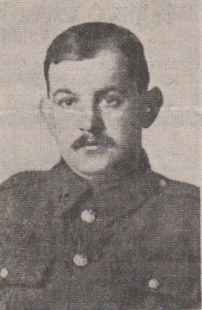
Fred Ormerod

Private 26469
2nd/5th Bn, Duke of Wellington's (West Riding Regt)
Fred Ormerod was killed in action on 4 February 1918, and is buried in Roclincourt Military Cemetery, France (Grave Ref. IV. A. 3).
Roclincourt is a village a little to the east of the road from Arras to Lens.
The 2nd/5th Battalion was formed at Huddersfield in October 1914, and from 1 March 1915 it was attached to the 186th Brigade, 62nd Division.
On 5th January 1918, the Division had taken over the front line in the Arras area, between Gavrelle and Oppy.
On the 30 January 1918, following heavy losses, the 2nd/5th Battalion was absorbed by the 1st/5th Battalion, but remained part of the 186th Brigade, 62nd Division.
The War Diary of the newly amalgamated records for 1-4 February 1918:
"1918 Feb. 1. The new amalgamated Battalion continued its reorganisation during the day and became 5th. Duke of Wellington's (West Riding) on the merging of the 1/5th. and 2/5th. Battalions. Lieut. Col. J. Walker (Commanding Officer of 1/5th. West Riding Regiment) was appointed Commanding Officer, Lieut. Col. F. Brook (Commanding Officer of the 2/5th. Duke of Wellington's) was appointed Second in Command, Capt. K. Sykes M.C. (Adjutant of 1/5th. West Riding Regiment) remained as Adjutant of the new battalion. Company Commanders were - "A" - Capt. G.L. Tinker (of 2/5th.) "B" Capt G.V. Bernays M.C. (of 2/5th.), "C" - Capt. C.G.H. Ellis (of 1/5th.) "D" - Capt. H.O. Browning M.C. (of 1/5th.) "A" and "B" Companies consisted of the old 2/5th. Battalion mean and "C" and "D" Companies were made up by the nucleus of 1/5th Battalion and drafts from the disbanded 2/6th. Duke of Wellington's Regiment.
In the evening the battalion left billets at ST. AUBIN and relieved the 2/5th York and Lancaster Regiment and the 2/5th. King's Own Yorkshire Light Infantry in the left sub-section of the GAVRELLE SECTOR. The battalion entrained on the light railway at ST. AUBIN at 5.pm. and detrained at CHANTECLER SIDING (G6.d.7.4.) From there the troops marched into the line. The battalion held the line from the GAVRELLE ROAD (C.25.a.6.6.) to B.18.d.70.00. Companies were disposed as follows - "C" Company the right of MILL POST (C.19.c.65.,15) to C.19.c.80.70, "B" Company left of MILL POST (C.19.c.80.70) to C.19.c.45.35), "A" Company - BRADFORD POST (C.19.a.20.50 to B.24.b.85.75) "D" Company were in support with three platoons in MARINE TRENCH (B.30.a. central to B.24.d.25.80) and the fourth platoon in support to "A" Company. Relief went smoothly and was completed by 11.30 pm.
2nd. Dull day. Slightly misty in the morning. Quiet during the day. A little trench mortaring on the left of MILL POST in the evening, one man wounded.
3rd. Dull, cold and wet in early morning, but cleared into a bright day afterwards. A little scattered shelling during the day round "C" Company's Headquarters. Considerable hostile trench mortar activity on the left company in MILL POST as a result of which No. 2 Post and a wiring party from 186th Pioneer Company suffered 10 casualties (4 killed 6 wounded). It appeared as if it was a prelude to a raid but nothing transpired.
1918 Feb. 4. Bright clear day. Considerable aerial activity. Widely scattered hostile artillery activity."
The Commonwealth War Graves Debt of Honour Register records Fred as "F. Ormerod", but the Card Index to the First World War Army Medal Rolls shows that a Fred Omerod [sic] served with the West Riding Regiment as Private 26469.
Fred Ormerod also served with the Cheshire Regiment, as Private 41430, and the Labour Corps, as Private 36255, prior to joining the West Riding Regiment.
The Soldiers Died in the Great War Database records that Fred also served with the East Lancashire Regiment, as Private 26230. The Database notes that Fred was born and enlisted in the Army in Haslingden.
Fred is further remembered at http://haslingdenwarheroes.blogspot.com/2015/05/ormerod-fred-private-26469.html.
| Fred's grave in Roclincourt Military Cemetery | |
|
The area of the line held by 2/5th Bn, Duke of Wellington's (West Riding Regt) in early February 1918 (from British Trench Map 20-51BNW-10B-251018) |